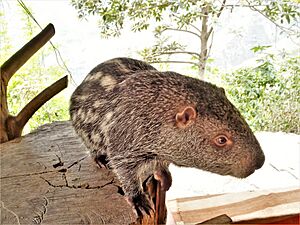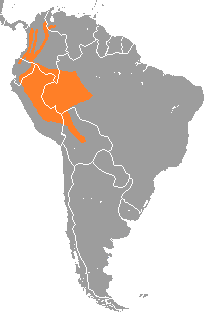Pacarana facts for kids
Quick facts for kids Pacarana |
|
|---|---|
 |
|
| Santa María del Mar District, Peru | |
| Conservation status | |
| Scientific classification | |
| Genus: |
Dinomys
|
| Species: |
branickii
|
 |
|
The pacarana (scientific name: Dinomys branickii) is a special kind of rodent found in South America. It's quite rare and moves slowly. Native people called it pacarana, which means "false paca." This is because it looks a bit like another rodent called the paca, even though they are not closely related.
Pacaranas have a thick body and are very large for a rodent. They can weigh up to 15 kilograms (about 33 pounds). They can also grow up to 79 centimeters (about 31 inches) long. This measurement does not even include their thick, furry tail!
Where Pacaranas Live
Pacaranas are active at night, which means they are nocturnal. They live only in the tropical forests of western South America. You can find them near the Amazon River basin and in the foothills of the Andes Mountains.
Their home range stretches from northwestern Venezuela and Colombia all the way to western Bolivia. This includes areas like the Yungas region. They are quite common in Cotapata National Park in Bolivia.
A Unique Rodent Family
The pacarana is the only living member of its rodent family, called Dinomyidae. This makes it very special! The paca, which it looks like, belongs to a different family.
Scientists first thought the pacarana was related to true mice. However, they later found out it belongs to the Dinomyidae family. This family also includes some amazing extinct animals. These include Phoberomys pattersoni and Josephoartigasia monesi. These were giant prehistoric rodents that lived in South America millions of years ago.
Pacarana Behavior
Pacaranas usually live in small family groups. These groups often have about four or five members.
Physical Characteristics
Pacaranas have four strong limbs and large heads. They are known as a scansorial species. This means they are good at climbing and moving around in trees. When they eat, they sit on their back legs. They use their front paws to hold their food.


